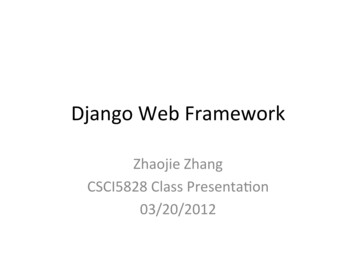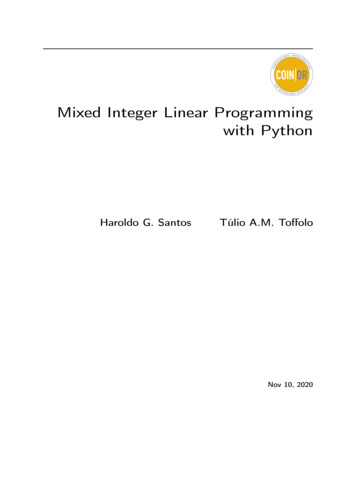
Transcription
Web Programming with Python (Django)Sutee ��อ Django 1.0 Web Site Development - Ayman Hourieh1Monday, August 29, 11
MVC pattern in web development Old and clumsy ways for web development Common Gateway Interface be difficult to work with require a separate copy of the program to be launched for each request Script languages such as Perl and PHP lacked unified frameworks2Monday, August 29, 11
A few years ago, the model-view-controller (MVC) pattern for web-bapplications was introduced. This software engineering pattern separ(model), user interface (view), and data-handling logic (controller) soit, designerscan work on the interface without worrying about dMVC pattern inWithwebdevelopment The better wayor management. Developers are able to program the logic of data hangetting into the details of presentation. As a result, the MVC pattern qits way into web languages, and serious web developers started to empreference to previous techniques.The following diagram illustrates how each of the components of the model-view-controller(MVC)patternfor webdevelopmentinteractswitheach otherto servea user request: Model: data User interface: view Data-handling logic: controller Why Python?Python is a general purpose programming language. Although it is uwide variety of applications, Python is very suitable for developing wIt has a clean and elegant syntax. It is supported by a large libraryof s3and contributed modules, which covers everything from multi-threadMonday, August 29, 11
Why Python? A clean and elegant syntax A large standard library of modules that covers a wide range of tasks Extensive documentation A mature runtime environment Support for standard and proven technologies such as Linux and Apache4Monday, August 29, 11
Why Django? Python web application frameworks Turbogears Grok Pyjamas and mores http://en.wikipedia.org/wiki/Comparison of Web application frameworks#Python5Monday, August 29, 11
Why Django? Tight integration between components Object-Relation Mapper Clean URL design Automatic administration interface Advanced development environment Multilingual support6Monday, August 29, 11
History of DjangoThe Web framework for perfectionists with deadlines7Monday, August 29, 11
Installing Django https://www.djangoproject.com/download/ extract and run: python setup.py install For Windows: copy the django-admin.py file from Django-x.xx/django/bin tosomewhere in your system path such as c:\windows You can test your installation by running this command: django-admin.py --version8Monday, August 29, 11
Setting up the database Edit settings.py fileDATABASE ENGINE 'django.db.backends.sqlite3'DATABASE NAME 'bookmarks.db'DATABASE USER ''DATABASE PASSWORD ''DATABASE HOST ''DATABASE PORT '' Run python manage.py syncdb Enter username, email, and password for the superuser account9Monday, August 29, 11
Launching the development server Run python manage.py runserver open your browser, and navigate to http://localhost:8000/ you can specify port in the command line python manage.py runserver port number 10Monday, August 29, 11
Building a Social Bookmarking Application11Monday, August 29, 11
Topics URLs and views: Creating the main page Models: Designing an initial database schema Templates: Creating a template for the main page Putting it all together: Generating user pages12Monday, August 29, 11
MTV framework In Django model model template view view controller13Monday, August 29, 11
Creating the main page view create a Django application inside our project python manage.py startapp bookmarks it will create a folder named bookmarks with these files init .py views.py models.py14Monday, August 29, 11
Creating the main page view Open the file bookmarks/views.py and enter the following:from django.http import HttpResponsedef main page(request):output u''' html head title %s /title /head body h1 %s /h1 p %s /p /body /html ''' % (u'Django Bookmarks',u'Welcome to Django Bookmarks',u'Where you can store and share bookmarks!')return HttpResponse(output)15Monday, August 29, 11
Creating the main page URL Open file urls.py and add an entry for the main pagefrom django.conf.urls.defaults import *from bookmarks.views import *urlpatterns patterns(‘’,r ‘ ’, main page),)16Monday, August 29, 11
Models: designing an initial database schema Django abstracts access to database table through Python classes For our bookmarking application, we need to store three types of data in thedatabase: Users (ID, username, password, email) Links (ID, URL) Bookmarks (ID, title, user id, link id)17Monday, August 29, 11
The link data model Open the bookmarks/models.py file and type the following code:from django.db import modelsclass Link(models.Model):url models.URLField(unique True)18Monday, August 29, 11
it's of the type models.URLFieldurl, andhe models.URLFieldA partial table of the field typesField typeIntegerFieldDescriptionAn om/en/dev/ref/models/fields/.INSTALLED APPS variable, andediting the settings.py19ding our application name (django bookmarks.bookmarks) to it:Monday, August 29, 11
The link data model การที่จะเริ่มใช้ model ของ application �่ จําเป็น activate ตัวapplication ก่อน � settings.pyINSTALLED APPS files','django bookmarks.bookmarks',) จากนั้นจึงสั่งpython manage.py syncdb สามารถดู SQL �python manage.py sql bookmarks20Monday, August 29, 11
The link data model To explore the API, we will use the Python interactive console. To launch theconsole, use the following command:python manage.py shell Using the Link model: from bookmarks.models import *link1 Link(url u'http://www.packtpub.com/')link1.save()link2 Link(url nk.objects.all()Link.objects.get(id 1)link2.delete()Link.objects.count()Monday, August 29, 1121
The link data model Django provides the convenient approach to manage the model You don't have to learn another language to access the database. Django transparently handles the conversion between Python objects andtable rows. You don't have to worry about any special SQL syntax for differentdatabase engines.22Monday, August 29, 11
The user data model Fortunately for us, management of user accounts is so common that Djangocomes with a user model ready for us to use. from django.contrib.auth.models import UserUser.objects.all()user User.objects.get(1)dir(user) We can directly use the User model without any extra code.23Monday, August 29, 11
The bookmark data model The Bookmark model has a many-to-many relationship between users andlinks these is the one-to-many relationship between the user and theirbookmarks these is the one-to-many relationship between a link and its bookmarksfrom django.contrib.auth.models import Userclass Bookmark(models.Model):title models.CharField(max length 200)user models.ForeignKey(User)link models.ForeignKey(Link)24Monday, August 29, 11
Templates: creating a template for the main page We embed the HTML code of the page into the view's code. This approachhas many disadvantages even for a basic view: Good software engineering practices always emphasize the separationbetween UI and logic Editing HTML embedded within Python requires Python knowledge Handling HTML code within the Python code is a tedious and error-pronetask Therefore, we'd better separate Django views from HTML code generation25Monday, August 29, 11
Templates: creating a template for the main page This template may contain placeholders for dynamic sections that aregenerated in the view. the view loads the template and passes dynamic values to it the template replaces the placeholders with these values and generatesthe page First, we need to inform Django of our templates folder. Open settings.pyimport os.path, sysTEMPLATE DIRS (os.path.join(sys.path[0], 'templates'),)26Monday, August 29, 11
Templates: creating a template for the main page Next, create a file called main page.html in the templates folder with thefollowing content: html head title {{ head title }} /title /head body h1 {{ page title }} /h1 p {{ page body }} /p /body /html 27Monday, August 29, 11
Templates: creating a template for the main page Edit the bookmarks/views.py file and replace its contents with thefollowing code:from django.http import HttpResponsefrom django.template import Contextfrom django.template.loader import get templatedef main page(request):template get template('main page.html')variables Context({'head title': u'Django Bookmarks','page title': u'Welcome to Django Bookmarks','page body': u'Where you can store and share bookmarks!'})output template.render(variables)return HttpResponse(output)28Monday, August 29, 11
Putting it all together: generating user pages Creating the URL The URL of this view will have the form user/username, where usernameis the owner of the bookmarks that we want to see. This URL is different from the first URL that we added because it containsa dynamic portion.urlpatterns patterns('',(r' ', main page),(r' user/(\w )/ ', user page),)29Monday, August 29, 11
Putting it all together: generating user pages Open the bookmarks/views.py file and enter the following code:from django.http import HttpResponse, Http404from django.contrib.auth.models import Userdef user page(request, username):try:user User.objects.get(username username)except User.DoesNotExist:raise Http404(u'Requested user not found.')bookmarks user.bookmark set.all()template get template('user page.html')variables Context({'username': username,'bookmarks': bookmarks})output template.render(variables)return HttpResponse(output)30Monday, August 29, 11
Putting it all together: generating user pages Create a file called user page.html in the templates directory html head title Django Bookmarks - User: {{ username }} /title /head body h1 Bookmarks for {{ username }} /h1 {% if bookmarks %} ul {% for bookmark in bookmarks %} li a href "{{ bookmark.link.url }}" {{ bookmark.title }} /a /li {% endfor %} /ul {% else %} p No bookmarks found. /p {% endif %} /body /html 31Monday, August 29, 11
Putting it all together: generating user pages Populating the model with data fromfromuserlinkdjango.contrib.auth.models import Userbookmarks.models import * User.objects.get(id 1) Link.objects.get(id 1) bookmark Bookmark(.title u'Packt Publishing',.user user,.link link. ) bookmark.save() user.bookmark set.all()32Monday, August 29, 11
User Registration and Management33Monday, August 29, 11
Topics Session authentication Improving template structures User registration Account management34Monday, August 29, 11
Session authentication The Django authentication system is available in the django.contrib.authpackage that is installed by default.INSTALLED APPS files','django bookmarks.bookmarks',)35Monday, August 29, 11
Session authentication Features of the auth package Users: A comprehensive user data model with fields commonly requiredby web applications Permissions: Yes/No flags that indicate whether a user may access acertain feature or not Groups: A data model for grouping more than one user together andapplying the same set of permissions to them Messages: Provides the functionality for displaying information and errormessages to the user36Monday, August 29, 11
Creating the login page Those who have worked on programming a session management system in alow-level web framework (such as PHP and its library) will know that this taskis not straightforward. Fortunately, Django developers have carefully implemented a sessionmanagement system for us and activating it only requires exposing certainviews to the user.37Monday, August 29, 11
Creating the login page First of all, you need to add a new URL entry to the urls.py file.urlpatterns patterns('',(r' ', main page),(r' user/(\w )/ ',user page),(r' login/ ', 'django.contrib.auth.views.login'),) The module django.contrib.auth.views contains a number of viewsrelated to session management. We have only exposed the login view fornow.38Monday, August 29, 11
Creating the login page The login view requires the availability of a template called registration/login.html in the templates directory. The login view passes passes an object that represents the login form to thetemplate. form.username generates HTML code for username form.password generates HTML code for password form.has errors is set to true if logging in fails after submitting theform39Monday, August 29, 11
Creating the login page Make a directory named registration within the templates directory,and create a file called login.html in it. html head title Django Bookmarks - User Login /title /head body h1 User Login /h1 {% if form.errors %} p Your username and password didn't match.Please try again. /p {% endif %} form method "post" action "." {% csrf token %} p label for "id username" Username: /label {{ form.username }} /p p label for "id password" Password: /label {{ form.password }} /p input type "hidden" name "next" value "/" / input type "submit" value "login" / /form /body /html Monday, August 29, 1140
Creating the login page It is a good idea to make the
Web Programming with Python (Django) Sutee Sudprasert ลอกมาจากหนังสือ Django 1.0 Web Site Development - Ayman Hourieh 1 Monday, August 29, 11 . MVC pattern in web development Old and clumsy ways for web development Common Gateway Interface be difficult to work with require a separate copy of the program to be launched for each request Script .










![Fluent Python : [clear, concise, and effective programming]](/img/1/799981060.jpg)
